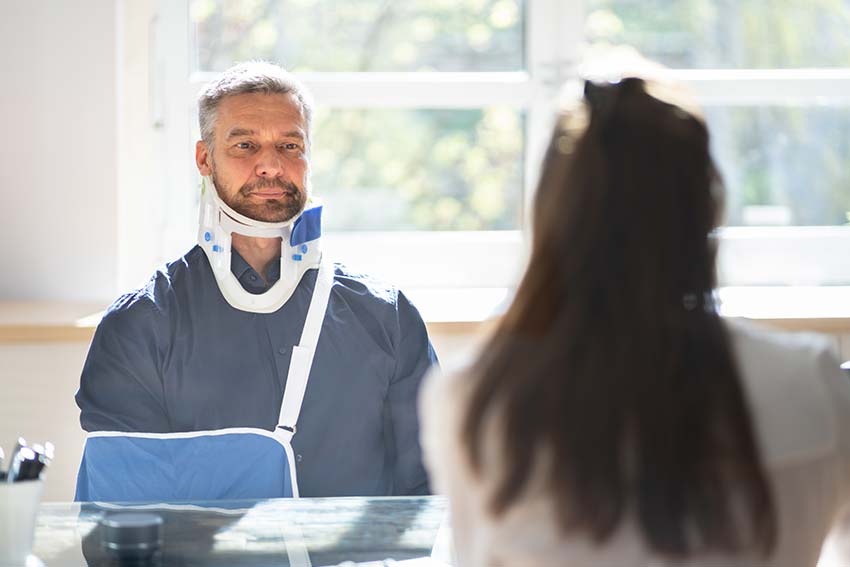The most important part of any personal injury claim is liability. If no party to the accident is liable, then the injured person cannot claim damages. Damages for personal injury whether it be for pain and suffering, medical expenses, or lost wages, are at the heart of any personal injury case.
So, there has to be some form of liability whether it’s in part, or full, on the part of another person or corporation. A party may attract liability due to their own negligence. Sometimes an employer may be vicariously liable for the actions of an employee.
Whatever the case, it’s important that you understand all these aspects of liability when it comes to your personal injury claim. Below we take a look at all there is to know about liability in personal injury cases.
Liability In Personal Injury Cases
When you suffer harm as a result of a personal injury caused by another person, you need to prove liability to claim damages. Proving liability in a personal injury lawsuit means you show fault on part of the other party. This means that the at-fault party either acted negligently or through their own intentional misconduct, caused the harm.
The starting point to understanding liability means understanding that everyone has a duty to act in a manner that does not cause injury to others. When a person fails to honour that duty and injury occurs, that person is said to be liable.
One can define liability as follows:
- A person has a duty to the general public.
- That person fails to perform the duty.
- Another person experiences harm or loss as a result of the failure to perform their duty.
- The person who failed to uphold their duty is liable for the damages caused by such failure.

Types Of Liability
Proving liability is a complex and in-depth process that requires the expertise of an experienced personal injury lawyer. That’s because there are different types of liability that may apply to a personal injury case.
For example, when it comes to negligence, there are several kinds. A personal injury claim may arise from general negligence, gross negligence, and comparative negligence (we will look at these in detail in the section below).
Other forms of liability include strict liability and vicarious liability.
Strict liability is a unique case in which an injured party is not required to prove intent or negligence. In some cases, where strict liability exists, the plaintiff (the party bringing the claim) only needs to prove that the defendant (at-fault or responsible party) engaged in certain conduct causing the harm.
Examples of strict liability include product liability claims (where there are defective products), dog bite claims, and dangerous activity claims.
Vicarious liability is when someone is held liable for the actions of another – usually an employer being held responsible for the wrongful conduct of an employee.
In most cases of personal injury liability, only the person who causes the harm is liable. But, vicarious liability allows a plaintiff to sue the employer of the at-fault party if they caused the harm during the course and scope of their employment.
Negligence And Liability
Liability for negligence may seem like a strange concept. How do you hold someone liable when they haven’t done anything? Liability as a result of negligence is usually where they have a duty to act but fail to do so. This is also known as a duty of care.
For example, say you sustain severe injuries as a result of an accident because the at-fault driver failed to stop at a red light. There is no positive act in that the driver did not intend to hit your car but they did as a result of their failure to act responsibly as a reasonable person should.
So, when it comes to proving negligence, the courts will generally adopt the reasonable person test. In other words, your personal injury lawyer will need to establish that the at-fault driver failed to act as a reasonable person would have in the same circumstances.
Winning your case and receiving a damages award means you have established the following successfully:
- The defendant owed you a duty of care
- The defendant breached the duty of care
- The breach of the duty of care was proximate or the causal link between the wrongdoing and the injury
- You sustained damages as a result of the breach of duty
There are several types of negligence that may result in liability.
General Negligence
These are your run-of-the-mill negligence cases. When it comes to proving these cases, your personal injury lawyer should apply the above principles.
Some examples of general negligence include a car accident with one at-fault driver who takes legal responsibility and slip-and-fall accidents where the property owner did not put proper warnings in place like a “wet floor” sign.
Gross Negligence
In some limited cases, the at fault party will only be found liable if their action amounted to Gross negligence. There is a far higher burden of proof when it comes to proving a gross negligence case. In some cases, Municipalities will only be found negligent if their actions are considered to have been grossly negligent.
Comparative Negligence
Comparative negligence applies in situations where not only one party is at fault. In other words, where you suffer injuries as a result of your own wrongdoing and someone else’s negligence, your damages will be reduced by the percentage you were contributorily negligent.
The court will make a ruling on the percentage that each at fault party is negligent. For example, if you are injured in a automobile accident and are found 25% at fault for the accident, you will have your damages reduced by 25%. The defendant will only be 75% liable for your damages.
The concept of comparative negligence is to ensure optimal fairness when determining damages. It also holds all parties to the lawsuit accountable and assists in matters where there are several at-fault drivers like in a multiple-car pile-up.

How To Determine Liability In A Personal Injury Case
Proving liability in a personal injury claim requires years of experience. Personal injury lawyers specialize in this field of law and have dealt with many different personal injury claims. An experienced lawyer can quickly identify the type of liability to establish.
Establishing liability can be done in one of two ways. Either the at-fault party can admit to responsibility or the jury will hear evidence on the matter and make a decision.
In the latter instance, the process is quick, and easy, and does not result in a civil lawsuit. This is a common way in which we determine liability when a car accident occurred.
Hiring a personal injury lawyer is beneficial here as they will guide you through the process of making a claim and help you receive fair compensation for your injury.
In more complex cases that involve comparative negligence or medical malpractice, it’s not always easy to determine liability. In this instance, a civil lawsuit is held and the jury will hear evidence.
In this case, it’s imperative that you reach out to a personal injury lawyer. You will need to obtain as much evidence as possible to prove your case in a timely manner. Your lawyer will explain all your legal options and help to gather your medical records and all other important evidence to ensure the jury finds it in your favour.
Your lawyer will also need to reach out to your insurance company to inform them of the civil lawsuit.
Once the jury has heard all the evidence from both the plaintiff and the defendant, they will then hand down their verdict. They could either find the defendant to be fully liable, partly liable, or not liable at all.
Types Of Personal Injury Cases And Who Can Be Held Liable
When you have suffered injuries as a result of the wrongdoing of another, you will want to hold them liable.
But personal injury claims are not always that simple. Sometimes, there are multiple parties involved or different types of liability that may apply to different types of accidents. That’s why it’s always best to consult your personal injury team to ascertain all your legal options.
Below, we take a look at four common areas in which personal injuries are likely to arise and who you can hold liable.
Slips And Falls
Slips and falls happen every day and many people suffer life-changing personal injuries because of them.
Some of the most common slips and falls accidents include:
- Falling down a staircase without rails
- Tripping over an uneven floor
- Falling over a broken or uneven sidewalk
- Falling down broken or missing steps
- Slipping on a wet surface
- Sustaining an injury due to inadequate lighting
The nature of these accidents means they often happen on public or private property. So it’s not always easy to decipher who the liable party is. It could be the property owner, a tenant, or even a governmental department.
One thing that is always important to consider when determining liability is to look at who may have had the responsibility to guard you against harm. In other words, the moment you step onto someone else’s property, they are legally required to ensure that the space is safe for use.
A sign or a warning should bring to your attention any hazardous conditions that may have an effect on your safety. Failure to do so means the property owner is negligent and may be held liable.
Car Accidents
Car accidents are another common cause of personal injury claims. While it’s easier to decipher who the at-fault party is, you will still require the services of an experienced personal injury lawyer. This is because there are many different legal issues involved.
Some accidents may be straightforward. For example, a negligent or reckless driver crashes into you and you suffer harm as a result. In this case, the at-fault party is clear, and establishing liability is often easy. Your personal injury lawyer will assist with gathering evidence and submitting your claim to your insurance company.
The more complicated car accident cases arise when there are multiple parties at fault and where one party may be acting in the course and scope of his employment. In other words, the at-fault party drives a work vehicle at the time of the accident.
When these other factual circumstances exist, establishing liability becomes tricky. For example, where multiple parties acted negligently, comparative negligence may apply to the case. No party is 100% liable so the damages payable will reflect the extent or percentage they contributed to the harm.
There are also instances where an employer may be held liable if their employee causes harm during the course and scope of their employment. In this instance, the employer is vicariously liable.
For example, if a delivery driver is carrying out his deliveries for the day when he fails to stop at a red light. The liable party is the driver, but because he was completing his work duties in a work vehicle, the company may also be joined in the legal proceedings.

Professional Malpractice
Professional malpractice occurs when a person acting in the course and scope of their profession acts negligently. When someone is a professional in a certain field, they are expected to act with a certain degree of care and skill to ensure the safety of other persons.
A common example of professional malpractice is in the medical field. Medical malpractice often occurs when a health care professional while acting in the course and scope of his employment, through a negligent act or omission, deviates from his professional standards and causes harm. In this instance, it is always in your best interest to seek help from a personal injury lawyer.
Medical malpractice claims require knowledge of the law and attention to detail. You are expected to submit all medical records to court and may require expert evidence from a doctor who can explain the negligent act or omission to the jury.
In a professional malpractice case, the liable party is often not the professional who acted negligently. Usually, you report the professional to the necessary regulatory board for negligence or misconduct and then the party to the personal injury proceeding is the company or organization for which he/she works. This is another example of vicarious liability.
So, when it comes to professional malpractice, you will require the guidance of an attorney when submitting a statement to the insurance adjuster as there are many important evidentiary aspects and time limits to adhere to.
Dog Bites
Dog bites are a unique instance of strict liability. They are also potentially complicated personal injury claims that sometimes require the expert evidence of a dog behaviourist.
Usually, however, the owner of a dog that bites and injures another person is strictly liable. In Ontario dog bites are governed by the Dog Owners Liability Act. https://www.ontario.ca/laws/statute/90d16
Dog owners have a duty to ensure that their dog does not harm another person and will be he liable for damages resulting from a bite or attack by the dog on another person or domestic animal.
Strict liability applies only if the injured person was lawfully on the property where the dog bite occurred. In other words, if the injured person was trespassing at the time of the incident, there is a chance that no liability will arise.
Premises Liability And The Ontario Occupiers’ Liability Act
The general rule is that property owners have a duty to ensure that their property is reasonably safe for anyone invited onto their property. So, in the instance where a person suffers a personal injury due to the negligence of a property owner to maintain his property, liability may arise.
The most common premises liability cases are slip and fall injuries due to insufficient property maintenance and upkeep. The Ontario Occupiers’ Liability Act gives clarity on who an occupier is and the circumstances in which liability may arise.
The Act defines an occupier as follows: An owner, tenant, or another person who is in possession of premises or has responsibility or control over the premises and the activities allowed on the premises.
In the instance where there are tenants on a property, liability may be more complex. This is because, based on the terms of the lease contract, the tenant may or may not be liable for the care and maintenance of the property rather than the owner of the property.
For example, landlords are often responsible for the maintenance and upkeep of a property to ensure their tenants and guests can use and enjoy the property safely. But, if the injury results from an issue that the tenant could prevent, then they may be liable and not the landlord.
Legal Obligations Of Property Owners Under The Act
The Act places certain legal obligations on an owner. Failure to comply with these obligations may lead to a successful damages claim due to personal injury.
The following are examples of premises where an owner or occupier is responsible for user safety:
- Stores and restaurants
- Schools
- Factories and office blocks
- Hotels
- Healthcare facilities and retirement villages
- Parking lots
- Municipal and government public spaces like sidewalks
- Amusement parks
- Private homes
In the above cases, occupiers must ensure the upkeep of the property so that tenants and patrons do not suffer personal injury.
Property Owners May Not Be Liable In Certain Circumstances
The Act also sets out certain instances when property owners will likely not attract liability. These are the following:
- When someone enters the property and willingly assumes that there may be an element of risk, an occupier may not be liable for their personal injury.
- When someone enters a property illegally or trespasses.
- When someone enters a property with the intention of carrying out criminal activity.
- When someone enters a property for the purposes of a recreational activity and has not paid a fee to do so, they will be deemed to have willingly assumed the risks of doing so.
Final Thoughts
Sustaining a personal injury can be life-changing. You may incur hefty medical bills and could even lose out on wages while you take time to recover. So, you don’t need the added stress of navigating a personal injury lawsuit or insurance claim on your own.
There are so many different legal principles applicable to claims that require legal knowledge and experience. Holding the correct party liable and understanding all your legal options is a part of that. Without legal assistance, your claim may be delayed or even dismissed in court. This can all be prevented with legal assistance.
If you have sustained a personal injury, reach out to a legal practitioner at our firm for a free consultation. At Fosters Law, our personal injury law firm puts your best interests first. Our team of experienced lawyers will advise you and assist with all aspects of your claim so that you receive the compensation you deserve. Contact us to learn more about how we can help make sense of your case.




